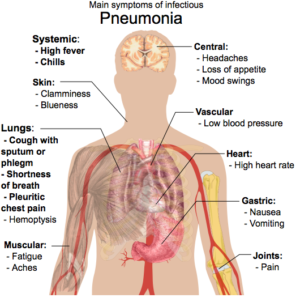By Avery Hatfield and Kaeyla Grandison; Farnsley Middle School (Louisville, KY)
When Kaeyla (co-author) was 8 years old, she didn’t feel well,.
“I had chest pain, a headache, loss of appetite, low energy. I was tired, I had a burning in my chest, a sore throat, fever, rare chills, coughing, and I had trouble breathing.”
Her doctor, Paul Diebold, diagnosed her with atypical pneumonia.
According to the Centers of Disease Control and Prevention (CDC), “Atypical Pneumonia is an infection in the lungs caused by viruses, bacteria, or fungus.” The more common name for atypical pneumonia is walking pneumonia.

Pneumonia, as stated by Wikipedia, is an “infection that inflames one or both lungs, which may fill up with fluid.” The difference between atypical and normal pneumonia is that atypical pneumonia is “mild” and usually doesn’t require hospitalization or bedrest. Regular pneumonia can put you in the hospital if it gets too severe.
According to Lung India, a medical Journal, both pneumonias are caused by pathogens like Streptococcus pneumoniae, Staphylococcus aureus, and Klebsiella pneumoniae. Common symptoms include, a fever, confusion, which is most commonly with older adults, muscle aches, joint stiffness, and sweaty and clammy skin.
According to the Mayo Clinic, to diagnose someone with atypical pneumonia doctors need to culture the mucus from the lungs (sputum), swab the throat, do a chest x-ray, obtain a complete blood count, and test for specific antigens or antibodies in the blood. The distinction between the two different types of pneumonias is very difficult to confirm.
Is atypical pneumonia contagious? According to Wikipedia, atypical pneumonia is spread through a sneeze or a cough. “If you end up getting this. you could be contagious for up to 10 days!”
According to Medline Plus, it is possible to get severe lung damage from atypical pneumonia.
According to the Mayo Clinic, if you have had atypical pneumonia once, you may have a weakened immune system, which may put you more at risk of getting atypical pneumonia again.
“You should stay home and while you are at home you need to take your medicine,” said Diebold during Kaeyla’s office visit. “Then you should be able to go back to school without getting anyone else sick.”
Atypical pneumonia is treatable. According to Medline Plus, a common way to get rid of atypical pneumonia is to get plenty of rest, drink plenty of water, drink cough syrup to help stop the cough, and consider taking over-the-counter medicines such as Tylenol and Advil. Kaeyla also took the antibiotic amoxicillin (a bacterial infection medication), along with cough syrup. and some allergy pills.
She had the same pneumonia again, but has gotten over it. “I am now better and I am no longer sick. Each time I’ve had it it’s taken about 4-5 weeks to recover,” she adds.

This work is licensed under a Creative Commons Attribution-NonCommercial-NoDerivs 3.0 Unported License.














Thanks, Rod Carden for scijourner.org